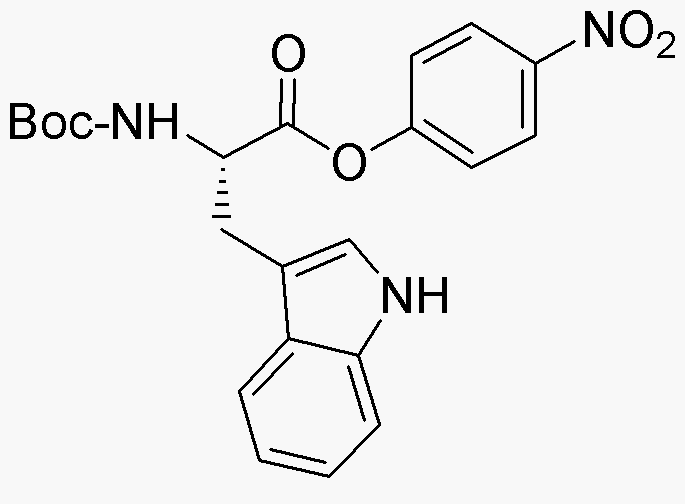Na-Boc-L-tryptophan 4-nitrophenyl ester is widely utilized in research focused on:
- Peptide Synthesis: This compound serves as a key building block in the synthesis of peptides, particularly those involving tryptophan. Its protective Boc group allows for selective reactions, making it easier to construct complex peptide sequences.
- Drug Development: In pharmaceutical research, it is used to create derivatives that can enhance the bioavailability of drugs. The incorporation of tryptophan can improve the pharmacological properties of compounds, making them more effective.
- Bioconjugation: It is applied in bioconjugation techniques, where it helps in attaching biomolecules to surfaces or other molecules. This is crucial in developing targeted drug delivery systems and diagnostic tools.
- Research on Neurotransmitters: Given tryptophan's role as a precursor to serotonin, this compound is valuable in studies exploring neurotransmitter pathways and their implications in mental health and mood disorders.
- Fluorescent Labeling: The nitrophenyl group can be utilized in fluorescent labeling applications, aiding in the visualization of biological processes in live cells, which is essential for cellular and molecular biology research.
General Information
Properties
Safety and Regulations
Applications
Na-Boc-L-tryptophan 4-nitrophenyl ester is widely utilized in research focused on:
- Peptide Synthesis: This compound serves as a key building block in the synthesis of peptides, particularly those involving tryptophan. Its protective Boc group allows for selective reactions, making it easier to construct complex peptide sequences.
- Drug Development: In pharmaceutical research, it is used to create derivatives that can enhance the bioavailability of drugs. The incorporation of tryptophan can improve the pharmacological properties of compounds, making them more effective.
- Bioconjugation: It is applied in bioconjugation techniques, where it helps in attaching biomolecules to surfaces or other molecules. This is crucial in developing targeted drug delivery systems and diagnostic tools.
- Research on Neurotransmitters: Given tryptophan's role as a precursor to serotonin, this compound is valuable in studies exploring neurotransmitter pathways and their implications in mental health and mood disorders.
- Fluorescent Labeling: The nitrophenyl group can be utilized in fluorescent labeling applications, aiding in the visualization of biological processes in live cells, which is essential for cellular and molecular biology research.
Documents
Safety Data Sheets (SDS)
The SDS provides comprehensive safety information on handling, storage, and disposal of the product.
Product Specification (PS)
The PS provides a comprehensive breakdown of the product’s properties, including chemical composition, physical state, purity, and storage requirements. It also details acceptable quality ranges and the product's intended applications.
Certificates of Analysis (COA)
Search for Certificates of Analysis (COA) by entering the products Lot Number. Lot and Batch Numbers can be found on a product’s label following the words ‘Lot’ or ‘Batch’.
Numéro de catalogue
Numéro de lot/série
Certificates Of Origin (COO)
This COO confirms the country where the product was manufactured, and also details the materials and components used in it and whether it is derived from natural, synthetic, or other specific sources. This certificate may be required for customs, trade, and regulatory compliance.
Numéro de catalogue
Numéro de lot/série
Safety Data Sheets (SDS)
The SDS provides comprehensive safety information on handling, storage, and disposal of the product.
DownloadProduct Specification (PS)
The PS provides a comprehensive breakdown of the product’s properties, including chemical composition, physical state, purity, and storage requirements. It also details acceptable quality ranges and the product's intended applications.
DownloadCertificates of Analysis (COA)
Search for Certificates of Analysis (COA) by entering the products Lot Number. Lot and Batch Numbers can be found on a product’s label following the words ‘Lot’ or ‘Batch’.
Numéro de catalogue
Numéro de lot/série
Certificates Of Origin (COO)
This COO confirms the country where the product was manufactured, and also details the materials and components used in it and whether it is derived from natural, synthetic, or other specific sources. This certificate may be required for customs, trade, and regulatory compliance.


